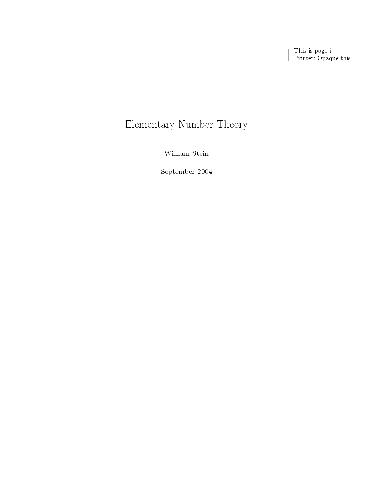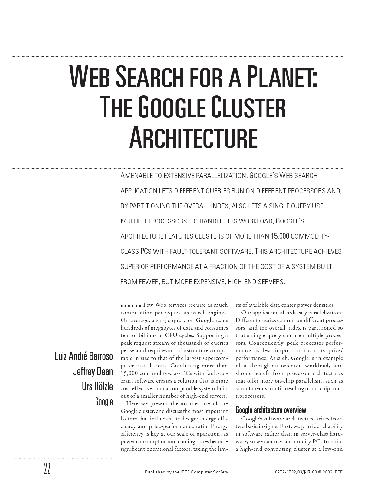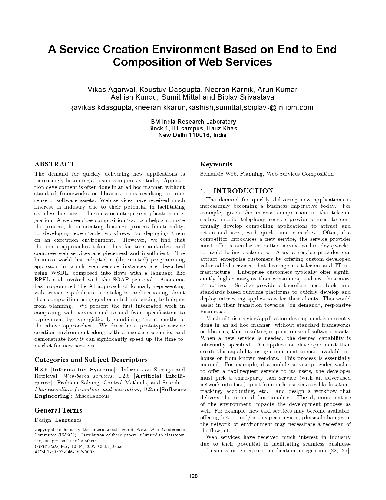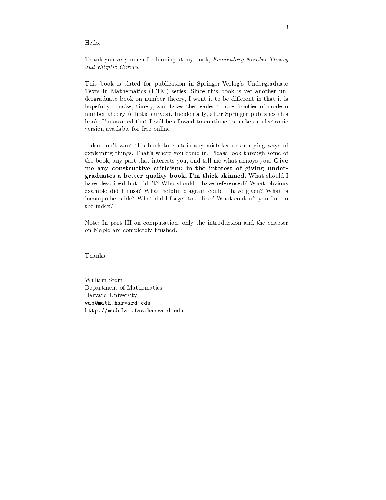John Davies, Rudi Studer, Paul Warren9780470025963, 0470025964
Table of contents :
Cover……Page 1
Semantic Web Technologies……Page 2
Contents……Page 6
Foreword……Page 12
1.1. SEMANTIC WEB TECHNOLOGIES……Page 16
1.2. THE GOAL OF THE SEMANTIC WEB……Page 17
1.3. ONTOLOGIES AND ONTOLOGY LANGUAGES……Page 19
1.4. CREATING AND MANAGING ONTOLOGIES……Page 20
1.5. USING ONTOLOGIES……Page 21
1.6. APPLICATIONS……Page 22
REFERENCES……Page 23
2.1. INTRODUCTION……Page 24
2.3. ONTOLOGY DEFINITION……Page 25
2.4. METHODOLOGY FOR SEMI-AUTOMATIC ONTOLOGY CONSTRUCTION……Page 26
2.5. ONTOLOGY LEARNING SCENARIOS……Page 27
2.6. USING KNOWLEDGE DISCOVERY FOR ONTOLOGY LEARNING……Page 28
2.6.1. Unsupervised Learning……Page 29
2.6.2. Semi-Supervised, Supervised, and Active Learning……Page 31
2.6.4. Focused Crawling……Page 33
2.6.5. Data Visualization……Page 34
2.7. RELATED WORK ON ONTOLOGY CONSTRUCTION……Page 37
ACKNOWLEDGMENTS……Page 39
REFERENCES……Page 40
3.1. INTRODUCTION……Page 44
3.2. INFORMATION EXTRACTION: A BRIEF INTRODUCTION……Page 46
3.2.1. Five Types of IE……Page 47
3.2.3. Mentions……Page 48
3.2.6. Events……Page 49
3.3. SEMANTIC ANNOTATION……Page 50
3.3.1. What is Ontology-Based Information Extraction……Page 51
3.4. APPLYING ‘TRADITIONAL’ IE IN SEMANTIC WEB APPLICATIONS……Page 52
3.4.2. Amilcare……Page 53
3.4.4. S-Cream……Page 54
3.5.1. Magpie……Page 55
3.5.3. SemTag……Page 56
3.5.4. Kim……Page 57
3.5.5. KIM Front-ends……Page 58
3.6. DETERMINISTIC ONTOLOGY AUTHORING USING CONTROLLED LANGUAGE IE……Page 60
3.7. CONCLUSION……Page 63
REFERENCES……Page 64
4.1. INTRODUCTION……Page 66
4.2. ONTOLOGY EVOLUTION: STATE-OF-THE-ART……Page 67
4.2.1. Change Capturing……Page 68
4.2.2. Change Representation……Page 69
4.2.3. Semantics of Change……Page 71
4.2.4. Change Propagation……Page 73
4.2.5. Change Implementation……Page 74
4.3. LOGICAL ARCHITECTURE……Page 75
4.4. DATA-DRIVEN ONTOLOGY CHANGES……Page 77
4.4.1. Incremental Ontology Learning……Page 79
4.5. USAGE-DRIVEN ONTOLOGY CHANGES……Page 81
4.5.1. Usage-driven Hierarchy Pruning……Page 82
4.6. CONCLUSION……Page 83
REFERENCES……Page 84
5.1. INTRODUCTION……Page 86
5.2.1. Paraconsistent Logics……Page 88
5.2.3. Belief Revision……Page 89
5.3.1. Inconsistency by Mis-representation of Default……Page 90
5.3.3. Inconsistency through Migration from Another Formalism……Page 92
5.3.4. Inconsistency Caused by Multiple Sources……Page 93
5.4.1. Inconsistency Detection……Page 94
5.4.2. Formal Definitions……Page 95
5.5. SELECTION FUNCTIONS……Page 97
5.6. STRATEGIES FOR SELECTION FUNCTIONS……Page 98
5.7 SYNTACTIC RELEVANCE-BASED SELECTION FUNCTIONS……Page 100
5.8.1. Implementation……Page 102
5.8.2. Experiments and Evaluation……Page 103
5.9. DISCUSSION AND CONCLUSIONS……Page 106
REFERENCES……Page 107
6.1. INTRODUCTION……Page 110
6.2. APPROACHES IN ONTOLOGY MEDIATION……Page 111
6.2.2. Ontology Mapping……Page 112
6.2.3. Ontology Alignment……Page 115
6.2.4. Ontology Merging……Page 117
6.3. MAPPING AND QUERYING DISPARATE KNOWLEDGE BASES……Page 119
6.3.1. Mapping Language……Page 121
6.3.2. A (Semi-)Automatic Process for Ontology Alignment……Page 123
6.3.3. OntoMap: an Ontology Mapping Tool……Page 125
6.4. SUMMARY……Page 126
REFERENCES……Page 127
7.1. INTRODUCTION……Page 130
7.2. ONTOLOGY USAGE SCENARIO……Page 131
7.3. TERMINOLOGY……Page 132
7.3.1. Data Qualia……Page 134
7.3.2. Sorts of Data……Page 135
7.4. ONTOLOGIES AS RDBMS SCHEMA……Page 138
7.5. TOPIC-ONTOLOGIES VERSUS SCHEMA-ONTOLOGIES……Page 139
7.6.1. Design Rationales……Page 141
7.6.2. Basic Structure……Page 142
7.6.3. Scope, Coverage, Compliance……Page 143
7.6.4. The Architecture of Proton……Page 145
7.6.5. Topics in Proton……Page 146
7.6.6. PROTON Knowledge Management Module……Page 148
7.7. CONCLUSION……Page 150
REFERENCES……Page 151
8.2. KNOWLEDGE ACCESS AND THE SEMANTIC WEB……Page 154
8.2.1. Limitations of Current Search Technology……Page 155
8.2.2. Role of Semantic Technology……Page 157
8.2.3. Searching XML……Page 158
8.2.4. Searching RDF……Page 159
8.2.5. Exploiting Domain-specific Knowledge……Page 161
8.2.6. Searching for Semantic Web Resources……Page 165
8.2.7. Semantic Browsing……Page 166
8.3. NATURAL LANGUAGE GENERATION FROM ONTOLOGIES……Page 167
8.3.1. Generation from Taxonomies……Page 168
8.3.4. Ontogeneration……Page 169
8.3.5. Ontosum and Miakt Summary Generators……Page 170
8.4. DEVICE INDEPENDENCE: INFORMATION ANYWHERE……Page 171
8.4.1. Issues in Device Independence……Page 172
8.4.2. Device Independence Architectures and Technologies……Page 175
8.4.3. DIWAF……Page 177
8.5. SEKTAGENT……Page 179
8.6. CONCLUDING REMARKS……Page 181
REFERENCES……Page 182
9.1. INTRODUCTION……Page 186
9.2.1. Definition of Methodology for Ontologies……Page 187
9.2.2. Methodology……Page 188
9.3.1. Methodologies……Page 189
9.3.2. Ontology Engineering Tools……Page 192
9.3.3. Discussion and Open Issues……Page 193
9.4.1. Process……Page 195
9.4.2. Argumentation Support……Page 198
9.5. FIRST LESSONS LEARNED……Page 200
9.6. CONCLUSION AND NEXT STEPS……Page 201
REFERENCES……Page 202
10.1. SEMANTIC WEB SERVICES – A SHORT OVERVIEW……Page 206
10.2. THE WSMO APPROACH……Page 207
10.2.1. The Conceptual Model – The Web Services Modeling Ontology (WSMO)……Page 208
10.2.2. The Language – The Web Service Modeling Language (WSML)……Page 213
10.2.3. The Execution Environment – The Web Service Modeling Execution Environment (WSMX)……Page 219
10.3. THE OWL-S APPROACH……Page 222
10.3.1. OWL-S Service Profiles……Page 224
10.3.2. OWL-S Service Models……Page 225
10.4.1. The Semantic Web Services Ontology (SWSO)……Page 228
10.4.2. The Semantic Web Services Language (SWSL)……Page 231
10.5.1. Principles Underlying IRS-III……Page 233
10.5.2. The IRS-III Architecture……Page 235
10.5.3. Extension to WSMO……Page 236
10.6.1. Aims and Principles……Page 237
10.6.2. Semantic Annotations……Page 239
10.7.1. General Grounding Uses and Issues……Page 241
10.7.2. Data Grounding……Page 243
10.7.3. Behavioural Grounding……Page 245
10.8. CONCLUSIONS AND OUTLOOK……Page 247
REFERENCES……Page 249
11.1. INTRODUCTION……Page 252
11.2.1. Working Libraries……Page 253
11.2.2. Challenges……Page 254
11.2.3. The Research Environment……Page 256
11.3.1. The Starting Point……Page 257
11.3.2. Enhancing the Library with Semantic Technology……Page 259
11.4. THE USERS’ VIEW……Page 263
11.5.1. Ontology Engineering……Page 265
11.5.2. BT Digital Library End-user Applications……Page 266
11.5.3. The BT Digital Library Architecture……Page 267
11.6. FUTURE DIRECTIONS……Page 270
REFERENCES……Page 272
12.1. INTRODUCTION……Page 274
12.2. PROFILE OF THE USERS……Page 275
12.3. ONTOLOGIES FOR LEGAL KNOWLEDGE……Page 277
12.3.1. Legal Ontologies: State of the Art……Page 278
12.3.2. Ontologies of Professional Knowledge: OPJK……Page 280
12.3.3. Benefits of Semantic Technology and Methodology……Page 282
12.4. ARCHITECTURE 12.4.1. Iuriservice Prototype……Page 287
REFERENCES……Page 293
13.1. INTRODUCTION……Page 296
13.2. INTRODUCTION TO SERVICE-ORIENTED ARCHITECTURES……Page 297
13.3. A SEMANTIC SERVICE-ORIENTATED ARCHITECTURE……Page 299
13.4. SEMANTIC MEDIATION……Page 301
13.5. STANDARDS AND ONTOLOGIES IN TELECOMMUNICATIONS……Page 302
13.5.2. SID……Page 304
13.6. CASE STUDY……Page 305
13.6.2. The B2B Gateway Architecture……Page 307
13.6.3. Semantic B2B Integration Prototype……Page 309
13.6.4. Prototype Implementation……Page 312
13.7. CONCLUSION……Page 313
REFERENCES……Page 314
14.1. MANAGEMENT OF NETWORKED ONTOLOGIES……Page 316
14.2. ENGINEERING OF NETWORKED ONTOLOGIES……Page 317
14.3. CONTEXTUALIZING ONTOLOGIES……Page 318
14.4. CROSS MEDIA RESOURCES……Page 319
14.5. SOCIAL SEMANTIC DESKTOP……Page 321
14.6. APPLICATIONS……Page 322
Index……Page 324







Reviews
There are no reviews yet.